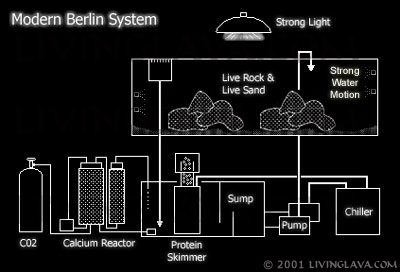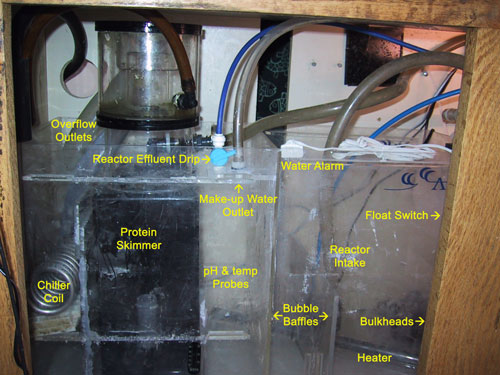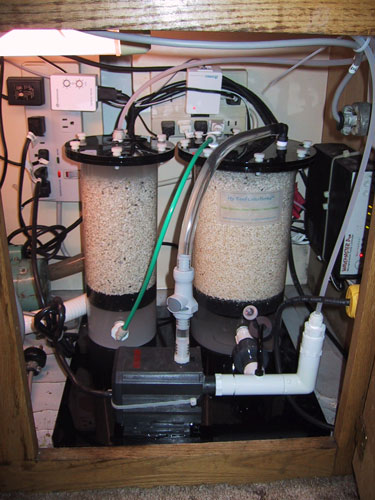

List of materials:
110 gallon glass
aquarium with oak stand and fan cooled, spectral aluminum lined canopy
Dual
400W Blueline E-Ballast Metal Halides, ICECAP 660 VHO w/ Solar
1000 Dimmer
200 pounds live rock (mostly Fiji)
150
pounds ESV oolitic aragonite, 90 pounds Caribsea Aragamax deep sand bed (DSB)
UltraLife
dual overflow with DIY Stockman
modification
Modified Amiracle sump with Blueline
1100 return pump
AquaC EV-150 protein skimmer with Blueline
1100 pump
My Reef CR-6 Calcium Reactor with
Iwaki MD15RT recirculation pump, 5# C02
bottle, Uniweld regulator, flowmeter
Red Sea Wavemaster Pro and a Reeftec
PE-1 and PE-2 wavemaker
Neptune AquaController II electronic temp/pH/ORP controller
AquaFX 4 stage RO/DI water filter
Sipedon float switch, Electric solenoid to control water level
Hagen Nutramatic Automatic Feeder
DIY Water Level Alarm
DIY
6-hour Feed Timer
UMI 1/4hp chiller
EboJager & Won Proheat Submersible heaters
Water Parameters:
Salinity : 1.025
Temp
: 80 F
pH : 8.0
(morning) to 8.3 (high noon)
alkalinity : 4.0meq/l
Ammonia : 0
Nitrite : 0
Nitrate : 0
Calcium : 480ppm
Phosphate: very low
Last update:02/03/2003
Filter Philosophy
My main filtration is live rock and live sand. As waste breaks down it releases ammonia. Bacteria breaks down ammonia to nitrite and another bacteria breaks down nitrite to nitrate. All these waste by-products are harmful to the delicate corals, fish, and various creatures in my system. Yet another bacteria breaks down nitrate to harmless nitrogen gas which bubbles up out of the water. This is an anaerobic bacteria because it lives in the zero-oxygen environment in the deepest parts of the rock and deep down in the sand. All the beneficial bacteria which coat the rock and sand in this system truly make them live.
My deep sand bed
(DSB) consists almost entirely of oolitic sand, commonly .5mm grain size,
and is over 4" high. This fine grain size allows for anaerobic layers,
sub-anaerobic layers, sub-sub and so forth. A larger grain size can not
support so many bacterial layers with only 4" of sand. The DSB is
also the host to a variety of worms, starfish, amphipods, copepods, bi-valves, anenomies
and more. The many living creatures on and in the rock combined with the
bugs and critters in the sand complete a natural system approximating
nature. Before waste and organic compounds have the chance to break down
they can be removed by a high power, quality protein
skimmer (see below). Multiple species
of macroalgae also act as nutrient sink.

Not all my corals require strong lighting. However, many of the corals in my reef hail from regions with intense tropical sun. Shown above are two 400 watt metal halides (MH) bulbs; both 20K Radium. Four 110 watt very high output (VHO) fluorescent bulbs; 3 50-50, 1 actinic. These bulbs come on in sequence, beginning with the early dawn with the VHOs controlled by a Solar 1000 v5.0 dimmer, then ramping up to the MHs. Then they shut off in reverse, ending in a calm dusk. Moonight simulation follows the lunar cycle. That's 1240 watts total or 11.3 watts per gallon!


Sump: Water flows down the tank overflow to the sump; the heart of the system. A submersed heater maintains temperature and a probe constantly monitors pH. A float switch replaces evaporated water when the water level drops. The water pumped in is called make-up water, its only freshwater (RO/DI) because salt stays behind when saltwater evaporates. A skimmer intake pumps water away at supper high speed to be shot through a protein skimmer. The skimmed water then returned to the sump. A small pump sends water to the calcium reactor which slowly comes back as calcium rich water via the effluent drip.
Skimmer: Water being moved through the an injected spray nozzle at high speed via a powerful Blueline 1100 pump. A gap of air between the nozzle and the water level causes air to be injected in to the water. The super-oxygenated water then enters the skimmer chamber. Waste and organic compounds bond with the bubbles and create foam. The foam rises in to the collection cup and reforms in to a foul, dark substance called skimmate, which is essentially sewage.

Water enters the reactor via a small volume pump. C02 gas is mixed with the water to lower the pH to 6.5. The recirculation pump pumps the 6.5pH water repeatedly through the main chamber. This slightly acidic water melts the aragonite media in the main chamber. Water then flows through the second chamber to strip C02 from the water which can affect tank pH. C02 can be further stripped by placing the return effluent near a highly agitated area, such as a protein skimmer intake. Dissolved aragonite releases calcium plus buffers the water from pH swings. The effluent drips back in to the sump ideally maintaining 450ppm Calcium and 3.5meq/l alkalinity at all times. Combined with low nitrates and no phosphates this is ideal water for coral growth.